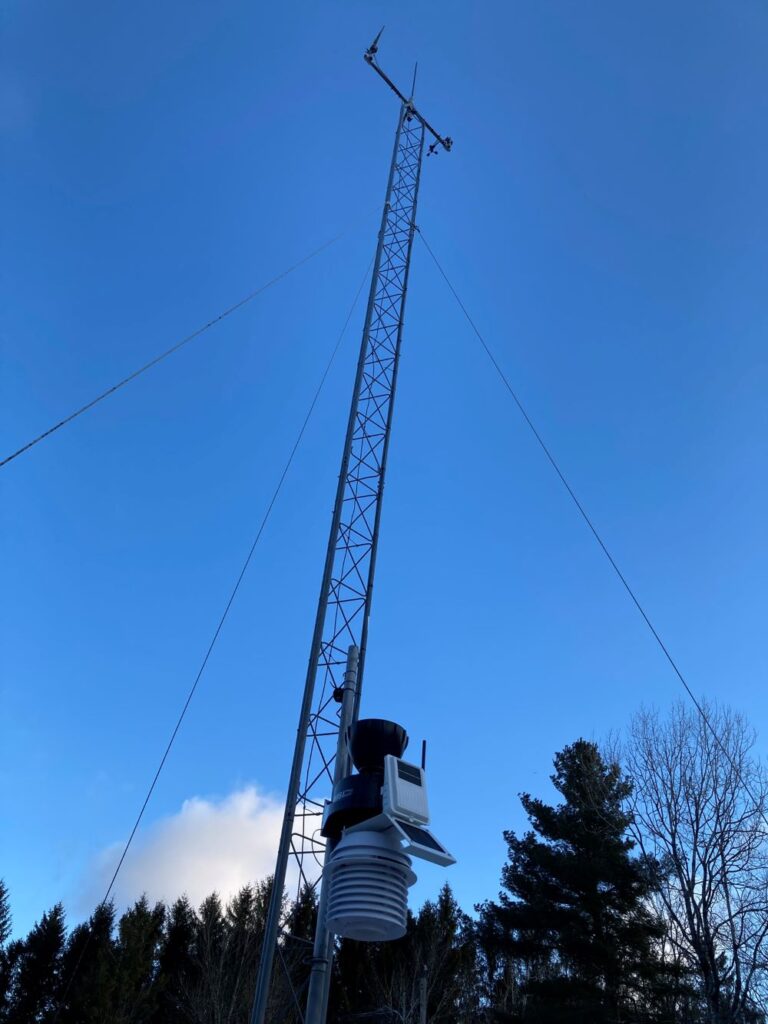A Look Back at Norfolk’s 2024 Weather
By Russell Russ

GMF’s weather station has a tower anemometer for measuring wind speed.
With an average yearly mean temperature of 48.6 degrees, 3.6 degrees above normal, 2024 was Norfolk’s warmest year (by a hair) over the last 93 years. The second warmest was 2012 with 48.5, followed by 1998 and 2023 coming in as tied for third warmest. The coldest year was 1940 at 41.9 degrees. In 2024, every single month came in above normal for monthly mean temperature. Eight of twelve months were high ranked for warmth (ranging from second to thirteenth.) There were ten days during the year that set or tied daily high temperature records. Those record highs occurred in the months of February, June, October and November. There were no days that set daily low temperature records. During all of 2024, there were just five days in the single digits and two days below zero. The coldest day was Dec. 23 with minus 4 and the warmest days were June 19 and 20, both with 90 degrees. At the weather station this year, there were two days at or above 90 degrees. This is about average.
The yearly total precipitation amount of 51.56 inches was just 0.97 inches below normal. With extremes noted throughout the year, it is surprising that the year came in very near average. The year’s precipitation surplus peaked after August at 7.27 inches. That was followed by three very dry months and after November the deficit was 1.29 inches. January was the wettest month with 7.84 inches, ranking as the fifth wettest January. October was the driest with just 0.67 inches, ranking as the second driest October. Three months – January, March and July – ranked high for wettest (ranging from fifth to eleventh). Four months – February, June, September and October – ranked high for driest (ranging from second to eighth.) Most notable was the very dry span of September and October. With a combined total precipitation amount of 1.85 inches, it ranked as the driest September-October span on record. These dry conditions lead to extreme forest fire danger levels, perhaps the worst locally in recent memory, from September through mid-November. In contrast, 2023 was dry up to mid-summer, with a deficit after July of 2.09 inches, then turned wet and closed the year with a peak surplus of 16.48 inches. The year 2023 ended up being Norfolk’s fifth wettest year. Norfolk’s wettest year was in 2011 with 77.28 inches and the driest was in 1965 with 33.89 inches.
Now comes the depressing part for snow lovers. Snowfall for the year was yet again below normal. With a total snowfall amount of 53.1 inches, 36.0 inches below normal, it was Norfolk’s seventh least snowy year. Seven of Norfolk’s eight “winter snow season” months were below normal for snowfall. Only January, with 26.2 inches, came in a little above normal. Norfolk’s snowiest year was in 1956 with 175.1 inches and the least snowy was in 1998 with just 33.0 inches. Nine of the top ten least snowy years have occurred since 1998. The 2023-24 winter season (October – May), with a snowfall total of 45.5 inches, ranked as the sixth least snowy. The winter of 2021-22, with 43.4 inches, ranked as third least snowy. For winter season snowfall, the 2024-25 season is not doing so well either. Through December, Norfolk was 9.4 inches below normal for winter season snowfall, and as of late January, 20.2 inches below normal. The winter of 2015-16 had the least amount of snowfall with 35.5 inches and 1955-56 had the most with 177.4 inches.
Weather observations and record keeping are performed by Russell Russ for the National Weather Service and Great Mountain Forest at Norfolk’s National Weather Service Cooperative Weather Observer Station, Norfolk 2SW.
Current weather conditions from Great Mountain Forest’s automated weather station are continuously transmitted to various weather networks all over the world. Weather Underground and CWOP (Citizen Weather Observer Program) are the most notable networks. Check out local conditions by accessing Weather Underground station KCTNORFO15 and CWOP station GW5867.
